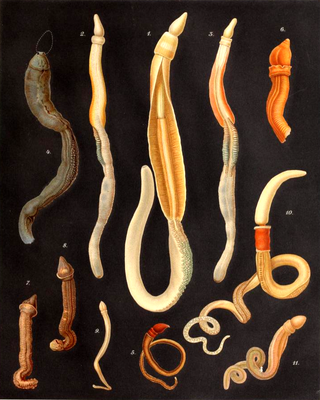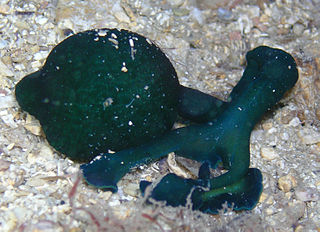
The Echiura, or spoon worms, are a small group of marine animals. Once treated as a separate phylum, they are now considered to belong to Annelida. Annelids typically have their bodies divided into segments, but echiurans have secondarily lost their segmentation. The majority of echiurans live in burrows in soft sediment in shallow water, but some live in rock crevices or under boulders, and there are also deep sea forms. More than 230 species have been described. Spoon worms are cylindrical, soft-bodied animals usually possessing a non-retractable proboscis which can be rolled into a scoop-shape to feed. In some species the proboscis is ribbon-like, longer than the trunk and may have a forked tip. Spoon worms vary in size from less than a centimetre in length to more than a metre.

Nemertea is a phylum of animals also known as ribbon worms or proboscis worms, consisting of 1300 known species. Most ribbon worms are very slim, usually only a few millimeters wide, although a few have relatively short but wide bodies. Many have patterns of yellow, orange, red and green coloration. The foregut, stomach and intestine run a little below the midline of the body, the anus is at the tip of the tail, and the mouth is under the front. A little above the gut is the rhynchocoel, a cavity which mostly runs above the midline and ends a little short of the rear of the body. All species have a proboscis which lies in the rhynchocoel when inactive but everts to emerge just above the mouth to capture the animal's prey with venom. A highly extensible muscle in the back of the rhynchocoel pulls the proboscis in when an attack ends. A few species with stubby bodies filter feed and have suckers at the front and back ends, with which they attach to a host.

The acorn worms or Enteropneusta are a hemichordate class of invertebrates consisting of one order of the same name. The closest non-hemichordate relatives of the Enteropneusta are the echinoderms. There are 111 known species of acorn worm in the world, the main species for research being Saccoglossus kowalevskii. Two families—Harrimaniidae and Ptychoderidae—separated at least 370 million years ago.

Urechis unicinctus, known as the fat innkeeper worm or penis fish, is a species of marine spoon worm in East Asia. It is found in Bohai Gulf of China and off the Korean and Hokkaido coasts. It is not to be confused with a closely related species, Urechis caupo, which occurs on the western coast of North America and shares common names. The body is about 10–30 centimetres (3.9–11.8 in) long, cylindrical in shape and yellowish-brown in color. On the surface of the body there are many small papillae.

Nereis vexillosa belongs to the phylum Annelida, a group known as the segmented worms. It is generally iridescent green and can reach 30 cm in length. It can be distinguished by the size of the upper ligules on the notopodia of the posterior region of the body. The upper ligules are much larger than the lower ligules. It is also without a collar-like structure around the peristomium.
Photis conchicola is a species of marine amphipod crustacean which lives in the Eastern Pacific Ocean. It grows to a length of 5.5 mm (0.22 in), and lives on rocky beaches among algae and surfgrass. It often inhabits discarded gastropod shells, which it attaches to marine plants.

Abarenicola pacifica or the Pacific lugworm is a large species of polychaete worm found on the west coast of North America and also in Japan. The worms live out of sight in burrows under the sand and produce casts which are visible on the surface.
Harrimania planktophilus is a marine acorn worm in the family Harrimaniidae. It lives in a burrow in sediment on the sea floor. It is only known from western Canada and was first described by Cameron in 2002. The species name is from the Greek and translates as "lover of plankton".
Listriolobus pelodes is a species of marine spoon worm. It is found in shallow seas in the North East Pacific off the coast of California. It lives in a burrow in soft sediments.

The arrow goby is a species of goby native to marine and brackish waters of the Pacific coast of North America from British Columbia to Baja California. This species grows to a length of 6.4 centimetres (2.5 in) SL, though most do not exceed 4.2 centimetres (1.7 in) TL. This fish can also be found displayed in public aquaria. This species is the only known member of its genus.
Odontosyllis phosphorea, commonly known as a fireworm, is a polychaete worm that inhabits the Pacific coast of North and Central America. The organism normally lives in a tube on the seabed, but it becomes bioluminescent when it rises to the surface of the sea during breeding season.
Saccoglossus bromophenolosus is a species of acorn worm occurring in the northwestern Atlantic Ocean and the northeastern Pacific Ocean. It grows to a length of about 20 cm (8 in) and lives in a burrow in soft sediment in the intertidal and subtidal zones. The scientific name refers to 2,4-dibromophenol, a secondary metabolite present in this worm.

Bonelliidae is a family of marine worms noted for being sexually dimorphic, with males being tiny in comparison with the females. They occupy burrows in the seabed in many parts of the world's oceans, often at great depths.

Serpula columbiana, variously called the calcareous tubeworm, plume worm, fan worm, limy tube worm and red tube worm, is a species of segmented marine polychaete worm in the family Serpulidae. It is a cosmopolitan species that is found in most seas in the Northern Hemisphere including the Atlantic Ocean, the Pacific Ocean and the Indian Ocean.

Lottia instabilis is a species of sea snail, a true limpet, a marine gastropod mollusk in the family Lottiidae. Common names include the unstable limpet, the unstable seaweed limpet and the rocking chair limpet. It is native to the northern Pacific Ocean where it feeds on kelp in the intertidal zone and the shallow sub-littoral zone.

Urechidae is a family of spoonworms in the subclass Echiura. The only genus in the family is Urechis, which has four species.

Ochetostoma erythrogrammon is a species of spoon worm in the family Thalassematidae. It is found in shallow water in the Atlantic Ocean, the Mediterranean Sea, and the Indian and Pacific Oceans, burrowing in soft sediment.

Echiurus echiurus is a species of spoon worm in the family Echiuridae. It is found in the North Atlantic Ocean and a subspecies is found in Alaska. It burrows into soft sediment and under boulders and stones in muddy places.
Themiste hennahi is a species of unsegmented benthic marine worm in the phylum Sipuncula, the peanut worms. It is native to shallow waters on the Pacific coast of North and South America. This worm was first described in 1828 by the British zoologist John Edward Gray as Themiste hennahi, the type specimen having been collected by the Rev. W. Hennah, with the type locality being Peru.
Maxmuelleria lankesteri is a species of spoon worm in the family Bonelliidae. It is found in the North Atlantic Ocean. It burrows into soft sediment on the seabed, mostly in deep water.












